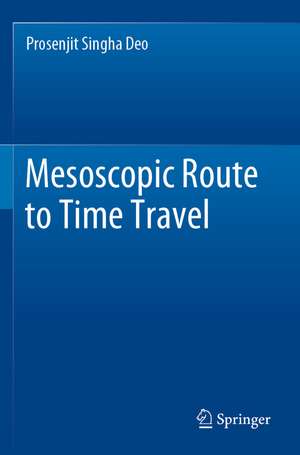Mesoscopic Route to Time Travel
Autor Prosenjit Singha Deoen Limba Engleză Paperback – 8 sep 2022
| Toate formatele și edițiile | Preț | Express |
|---|---|---|
| Paperback (1) | 773.41 lei 6-8 săpt. | |
| Springer Nature Singapore – 8 sep 2022 | 773.41 lei 6-8 săpt. | |
| Hardback (1) | 779.26 lei 6-8 săpt. | |
| Springer Nature Singapore – 7 sep 2021 | 779.26 lei 6-8 săpt. |
Preț: 773.41 lei
Preț vechi: 943.18 lei
-18% Nou
Puncte Express: 1160
Preț estimativ în valută:
147.100€ • 152.91$ • 123.11£
147.100€ • 152.91$ • 123.11£
Carte tipărită la comandă
Livrare economică 19 martie-02 aprilie
Preluare comenzi: 021 569.72.76
Specificații
ISBN-13: 9789811644672
ISBN-10: 9811644675
Pagini: 116
Ilustrații: XIII, 116 p. 56 illus., 6 illus. in color.
Dimensiuni: 155 x 235 mm
Greutate: 0.2 kg
Ediția:1st ed. 2021
Editura: Springer Nature Singapore
Colecția Springer
Locul publicării:Singapore, Singapore
ISBN-10: 9811644675
Pagini: 116
Ilustrații: XIII, 116 p. 56 illus., 6 illus. in color.
Dimensiuni: 155 x 235 mm
Greutate: 0.2 kg
Ediția:1st ed. 2021
Editura: Springer Nature Singapore
Colecția Springer
Locul publicării:Singapore, Singapore
Cuprins
Chapter I: Open systems.
Section 1.1 - Transport current
Section 1.2 - Aharonov-Bohm effect
Section 1.3 - Inclusion of magnetic field: Feynmann path approach
Chapter II: Closed systems
Section 2.1 - Parity effect in closed ring
Section 2.2 - Breakdown of parity effect
Chapter III: Larmor clock and Friedel sum rule
Section 3.1 - Larmor precision time
Chapter IV: Scattering in Q1D
Section 4.1 - A typical scattering problem in Q1D
Section 4.2 - Delta function potential in Q1D
Chapter V: Negative partial density of states
Section 5.1 - Burgers circuit: an introduction
Section 5.2 - Model potentials
Subsection 5.2.1 - Double delta function potential in one dimension
Subsection 5.2.2 - Stub potential
Subsection 5.2.3 - Delta function potential in Q1D
Subsection 5.2.4 - Three prong potential
Section 5.3 - Injectance and Friedel sum rule
Section 5.4 - Summary
Appendix A
Appendix B
Chapter VI: Time travel
Reflections
Section 1.1 - Transport current
Section 1.2 - Aharonov-Bohm effect
Section 1.3 - Inclusion of magnetic field: Feynmann path approach
Chapter II: Closed systems
Section 2.1 - Parity effect in closed ring
Section 2.2 - Breakdown of parity effect
Chapter III: Larmor clock and Friedel sum rule
Section 3.1 - Larmor precision time
Chapter IV: Scattering in Q1D
Section 4.1 - A typical scattering problem in Q1D
Section 4.2 - Delta function potential in Q1D
Chapter V: Negative partial density of states
Section 5.1 - Burgers circuit: an introduction
Section 5.2 - Model potentials
Subsection 5.2.1 - Double delta function potential in one dimension
Subsection 5.2.2 - Stub potential
Subsection 5.2.3 - Delta function potential in Q1D
Subsection 5.2.4 - Three prong potential
Section 5.3 - Injectance and Friedel sum rule
Section 5.4 - Summary
Appendix A
Appendix B
Chapter VI: Time travel
Reflections
Notă biografică
Prof. Prosenjit Singha Deo is working at the S.N Bose National Centre for Basic Sciences in Kolkata, India, since 1999. He has successfully guided several Ph.D. students leading to their Ph.D. in physics and also mentored a few postdocs. His works are mostly analytical and theoretical, but he has worked in close collaboration with experimentalists and co-authored many scientific papers with experimentalists. He has consistently worked on the problems elaborated in the book for over 25 years and more. He has also taught several courses in physics at the level of M.Sc. Before joining S. N. Bose Centre, he spent about 3 years in Europe as a postdoctoral fellow. He did his Ph.D. in physics in 1996 from the Institute of Physics, Bhubaneswar, India.
Textul de pe ultima copertă
This book gives a general introduction to theoretically understand thermodynamic properties and response to applied fields of mesoscopic systems that closely relate to experiments. The book clarifies many conceptual and practical problems associated with the Larmor clock and thus makes it a viable approach to study these properties. The book is written pedagogically so that a graduate or undergraduate student can follow it. This book also opens up new research areas related to the unification of classical and quantum theories and the meaning of time. It provides a scientific mechanism for time travel which is of immense fascination to science as well as society. It is known that developments in mesoscopic physics can lead to downscaling of device sizes. So, new or experienced researchers can have a quick introduction to various areas in which they might contribute in the future. This book is expected to be a valuable addition to the subject of mesoscopic physics.
Caracteristici
Clarifies several conceptual and practical problems associated with the Larmor clock
Opens up new research areas related to the unification of classical and quantum theories
Covers thermodynamics in detail and gives a good account of nonlinear and AC response
Opens up new research areas related to the unification of classical and quantum theories
Covers thermodynamics in detail and gives a good account of nonlinear and AC response
